The Identification of Ship Trajectories Using Multi-Attribute Compression and Similarity Metrics
Abstract
1. Introduction
1.1. Background
1.2. Literature Review
1.2.1. Trajectory Compression
1.2.2. Trajectory Similarity Metric
1.2.3. The Object of Clustering
1.2.4. Clustering Method
1.3. Novelty of the Study
- For the trajectory compression, we present the DP algorithm considering the SOG and COG. Compression thresholds are determined one by one for the change characteristics of each compression attribute.
- For the similarity measure of the trajectories, we construct the MSSPD model.
- For the clustering, we propose the SCCH metric that merges the silhouette coefficient metric (SC) and the Calinski–Harabaz (CH) metric. Based on the scores from the SCCH metric, we select the appropriate clustering parameters.
2. Research Methodology
2.1. Trajectory Compression
2.1.1. Improve the Theory of the DP Algorithm
2.1.2. Compression Threshold Determination
2.2. Similarity Metric
2.2.1. SSPD
- The direction of the ship trajectory cannot be identified. In particular, the incoming and outgoing ship trajectories of the same channel may be divided into a cluster of trajectories due to the similarity of the SSPD.
- Low utilization of the ship navigation information. The COG and SOG are also important components of the ship navigation at sea. However, according to the above, the trajectory similarity metric using the traditional SSPD only considers the latitude and longitude.
2.2.2. MSSPD
2.2.3. Comparing Different Distances
- Compression experiment. This experiment is used to test whether the distance of the trajectory similarity metric is affected by the compression algorithm. In this experiment, and are selected, where the original trajectory of is maintained and the trajectory is compressed using the proposed improved DP algorithm. The change in of each type of distance with the compression rate is observed.
- Noise experiment. This experiment is used to test whether the trajectory similarity metric distance is affected by noise. The algorithm selects and , leaves the original trajectory of unchanged, and artificially adds noise to . Observe the change in as the noise is gradually increased.
- Direction experiment. This experiment is used to test whether the trajectory similarity metric distance can detect two trajectories in opposite directions. The trajectories , , and are selected, and are calculated, and the values of the trajectory distances are observed.
2.3. Theory of the DBSCAN Algorithm
2.4. SCCH Score
3. Case Study
3.1. Data Characterization and Vessel Track Compression
3.2. Trajectory Clustering
3.3. Distribution of Extracted Traffic
- Extraction of shipping routes in different waters. Figure 15a,b,g show the ship traffic flow in Laotian waters. Figure 15c,d show the vessel traffic flow in Chengshanjiao waters. Figure 15e,f show the traffic flow in Penglai waters. The noise is filtered out, leaving the traffic conditions of each water separately, which in turn can be analyzed for the traffic of specific waters.
- Extraction of different shipping routes in the same waters. In Laotieshan waterway, Figure 15a,b extract the traffic routes to and from Chengshanjiao waterway and Laotieshan waterway, while Figure 15g extracts the traffic flow from Laotieshan waterway to Caofeidian port. By extracting different routes in the same water area, navigation patterns on various routes can be identified. This could provide a more objective basis for decision making by maritime traffic safety management.
- Identification of trajectory direction, taking Laotieshan waterway as an example for illustration. The Laotieshan Channel is a significant passage for large ships traveling to and from the Bohai Sea. Most ships travel between the west of the Bohai Sea and the east of the Yellow Sea through the Laotieshan Channel. The red arrow in the figure represents the direction of navigation. The westbound ship traffic is located on the barrier’s north side in the Laotieshan waterway, as shown in Figure 15b. Figure 15a shows that the eastbound ship traffic flow is located on the south side of the Laotieshan waterway barrier. The ability to detect the trajectory direction is due to the introduction of the MSSPD, which makes our method more efficient.
4. Discussion
4.1. Comparison with Other Clustering Algorithms
4.1.1. DBSCAN Algorithm Based on SSPD
- In the Laotieshan waters, the intersection of each cluster is slightly patchy, but the individual channels in the waters are extracted. This is since the SSPD is a metric based on the average distance between track points and track segments, and the SSPD is highly discriminative between tracks with different destinations in the same waters. It is also noise resistant. These properties are superior to the Hausdorff distance.
- In Chengshanjiao waters, the clustering effect is not optimistic. In the previous section, we analyzed two routes in Chengshanjiao waters; one was the incoming trajectory and the other was the outgoing trajectory. In the DBSCAN algorithm based on the SSPD, it appears that the inbound and outbound trajectories are grouped into one class. This is since the traditional SSPD is only the similarity measure for the ship’s position and does not consider the multidimensional information of the AIS data.
4.1.2. Spectral Clustering Algorithm Based on MSSPD
5. Conclusions
- The SOG and COG are considered to improve the DP algorithm. Position compression, velocity compression, and heading compression of trajectories are realized. The compression thresholds of each attribute are established one by one. When setting the compression thresholds at , , and , a balance of the conciseness and reliability can be achieved, which is a prerequisite for the accurate MSSPD metrics.
- For the multidimensional information of AIS data, the MSSPD is proposed and compression, noise, and directional experiments are conducted, respectively. For compression resistance, adjusting the appropriate compression threshold can effectively reduce the impact of the compression algorithm on the MSSPD and decrease to below 20%. With regard to the average distance used by the MSSPD, as the noise coefficient increases, remains stable with an amplitude ranging between 0% and 2%. In Section 2.2.3, and , which indicates that the MSSPD is sensitive to the trajectory’s direction. The MSSPD achieves better results in all three evaluation indices.
- For the problem of selecting clustering parameters, we propose the SCCH evaluation index. By analyzing the SCCH scores, we found that the SCCH achieves the highest score when is set to 0.05 and to 5. The SCCH score is utilized for adaptive parameter selection, and the algorithmic process is automated without requiring human intervention. Through experimental comparisons, we believe that the clustering algorithm that combines well with the MSSPD is the DBSCAN. Whether extracting different routes in the same water or extracting shipping lanes in different waters, the DBSCAN based on the MSSPD provides excellent performance.
Author Contributions
Funding
Institutional Review Board Statement
Informed Consent Statement
Data Availability Statement
Conflicts of Interest
References
- IMO. SOLAS Consolidated Edition; IMO: London, UK, 2014; ISBN 978-92-801-1549. [Google Scholar]
- Mazaheri, A.; Montewka, J.; Kujala, P. Towards an evidence-based probabilistic risk model for ship-grounding accidents. Saf. Sci. 2016, 86, 195–210. [Google Scholar] [CrossRef]
- Gil, M.; Montewka, J.; Krata, P.; Hinz, T.; Hirdaris, S. Determination of the dynamic critical maneuvering area in an encounter between two vessels: Operation with negligible environmental disruption. Ocean Eng. 2020, 213, 107709. [Google Scholar] [CrossRef]
- Li, Y.; Liu, R.W.; Liu, J.; Huang, Y.; Hu, B.; Wang, K. Trajectory compression-guided visualization of spatio-temporal AIS vessel density. In Proceedings of the 2016 8th International Conference on Wireless Communications & Signal Processing, Yangzhou, China, 13–15 October 2016; pp. 1–5. [Google Scholar]
- Zhang, S.; Liu, Z.; Cai, Y.; Wu, Z. Shi GAIS trajectories simplification threshold determination. J. Navig. 2016, 69, 729–744. [Google Scholar] [CrossRef]
- Zhao, L.; Shi, G. A method for simplifying ship trajectory based on improved Douglas–Peucker algorithm. Ocean Eng. 2018, 166, 37–46. [Google Scholar] [CrossRef]
- Patroumpas, K.; Alevizos, E.; Artikis, A.; Vodas, M.; Pelekis, N.; Theodoridis, Y. Online event recognition from moving vessel trajectories. GeoInformatica 2017, 21, 389–427. [Google Scholar] [CrossRef]
- Wang, L.; Chen, P.; Chen, L.; Mou, J. Ship AIS Trajectory Clustering: An HDBSCAN-Based Approach. J. Mar. Sci. Eng. 2021, 9, 566. [Google Scholar] [CrossRef]
- Zhang, M.; Kujala, P.; Musharraf, M.; Zhang, J.; Hirdaris, S. A machine learning method for the prediction of ship motion trajectories in real operational conditions. Ocean Eng. 2023, 233, 114905. [Google Scholar] [CrossRef]
- Zhao, L.; Shi, G. A trajectory clustering method based on Douglas-Peucker compression and density for marine traffic pattern recognition. Ocean Eng. 2019, 172, 456–467. [Google Scholar] [CrossRef]
- Buchin, K.; Buchin, M.; Wang, Y. Exact Algorithms for Partial Curve Matching via the Fréchet Distance. In Proceedings of the Twentieth Annual ACM-SIAM Symposium on Discrete Algorithms, SODA 2009, New York, NY, USA, 4–6 January 2009; ACM: New York, NY, USA, 2009. [Google Scholar] [CrossRef]
- Besse, P.; Guillouet, B.; Loubes, J.M.; François, R. Review and Perspective for Distance Based Trajectory Clustering. Comput. Sci. 2015, 47, 169–179. [Google Scholar] [CrossRef][Green Version]
- Wei, Y.; Chen, Z.; Zhao, C.; Chen, X.; He, J.; Zhang, C. A time-varying ensemble model for ship motion prediction based on feature selection and clustering methods. Ocean Eng. 2023, 270, 113659. [Google Scholar] [CrossRef]
- Xu, X.; Liu, C.; Li, J.; Miao, Y.; Zhao, L. Long-Term Trajectory Prediction for Oil Tankers via Grid-Based Clustering. J. Mar. Sci. Eng. 2023, 11, 1211. [Google Scholar] [CrossRef]
- Mou, J.M.; Chen, P.F.; He, Y.; Zhang, X. Fast adaptive spectral clustering algorithm for ship AIS trajectory. J. Harbin Eng. Univ. 2018, 39, 428–432. [Google Scholar]
- Gao, M.; Shi, G.Y. Ship-handling behavior pattern recognition using AIS sub-trajectory clustering analysis based on the T-SNE and spectral clustering algorithms. Ocean Eng. 2020, 205, 106919. [Google Scholar] [CrossRef]
- Cao, Y.Y.; Cui, Z.M.; Wu, J. A vehicle trajectory pattern learning method with improved Hausdorff distance and spectral clustering. Comput. Appl. Softw. 2012, 29, 38–40+113. [Google Scholar]
- Yang, C.H.; Lin, G.C.; Wu, C.H.; Liu, Y.-H.; Wang, Y.-C.; Chen, K.-C. Deep Learning for Vessel Trajectory Prediction Using Clustered AIS Data. Mathematics 2022, 10, 2936. [Google Scholar] [CrossRef]
- Xu, X.; Liu, C.; Li, J.; Miao, Y. Trajectory clustering for SVR-based Time of Arrival estimation. Ocean Eng. 2022, 259, 111930. [Google Scholar] [CrossRef]
- Wu, W.; Chen, P.; Chen, L.; Mou, J. Ship Trajectory Prediction: An Integrated Approach Using ConvLSTM-Based Sequence-to-Sequence Model. J. Mar. Sci. Eng. 2023, 11, 1484. [Google Scholar] [CrossRef]
- Yang, J.; Liu, Y.; Ma, L.; Ji, C. Maritime traffic flow clustering analysis by density-based trajectory clustering with noise. Ocean Eng. 2022, 249, 236–249. [Google Scholar] [CrossRef]
- Guo, S.Q.; Mou, J.M.; Chen, L.; Chen, P. Improved kinematic interpolation for AIS trajectory reconstruction. Ocean Eng. 2021, 234, 245–257. [Google Scholar] [CrossRef]
- Douglas, D.H.; Peucker, T.K. Algorithms for the reduction of the number of points required to represent a digitized line or its caricature. Cartogr. Int. J. Geogr. Inf. Geovisualization 1973, 10, 112–122. [Google Scholar] [CrossRef]
- Xu, X.F.; Cui, D.Q.; Li, Y.; Xiao, Y. Research on Ship Trajectory Extraction Based on Multi-Attribute DBSCAN Optimisation Algorithm. Pol. Marit. Res. 2021, 28, 136–148. [Google Scholar] [CrossRef]
- Series, M. Technical Characteristics for an Automatic Identification System Using Time-Division Multiple Access in the VHF Maritime Mobile Band; Recommendation ITU: Geneva, Switzerland, 2014; pp. 1371–1375. [Google Scholar]
- Zhang, Y.Q.; Shi, G.Y. Trajectory Similarity Measure Design for Ship Trajectory Clustering. In Proceedings of the 2021 IEEE 6th International Conference on Big Data Analytics (ICBDA), Xiamen, China, 5–8 March 2021; IEEE: Piscataway, NJ, USA, 2021. [Google Scholar] [CrossRef]
- Ester, M.; Kriegel, H.P.; Sander, J.; Xu, X. A Density-Based Algorithm for Discovering Clusters in Large Spatial Databases with Noise; AAAI Press: Menlo Park, CA, USA, 1996. [Google Scholar]
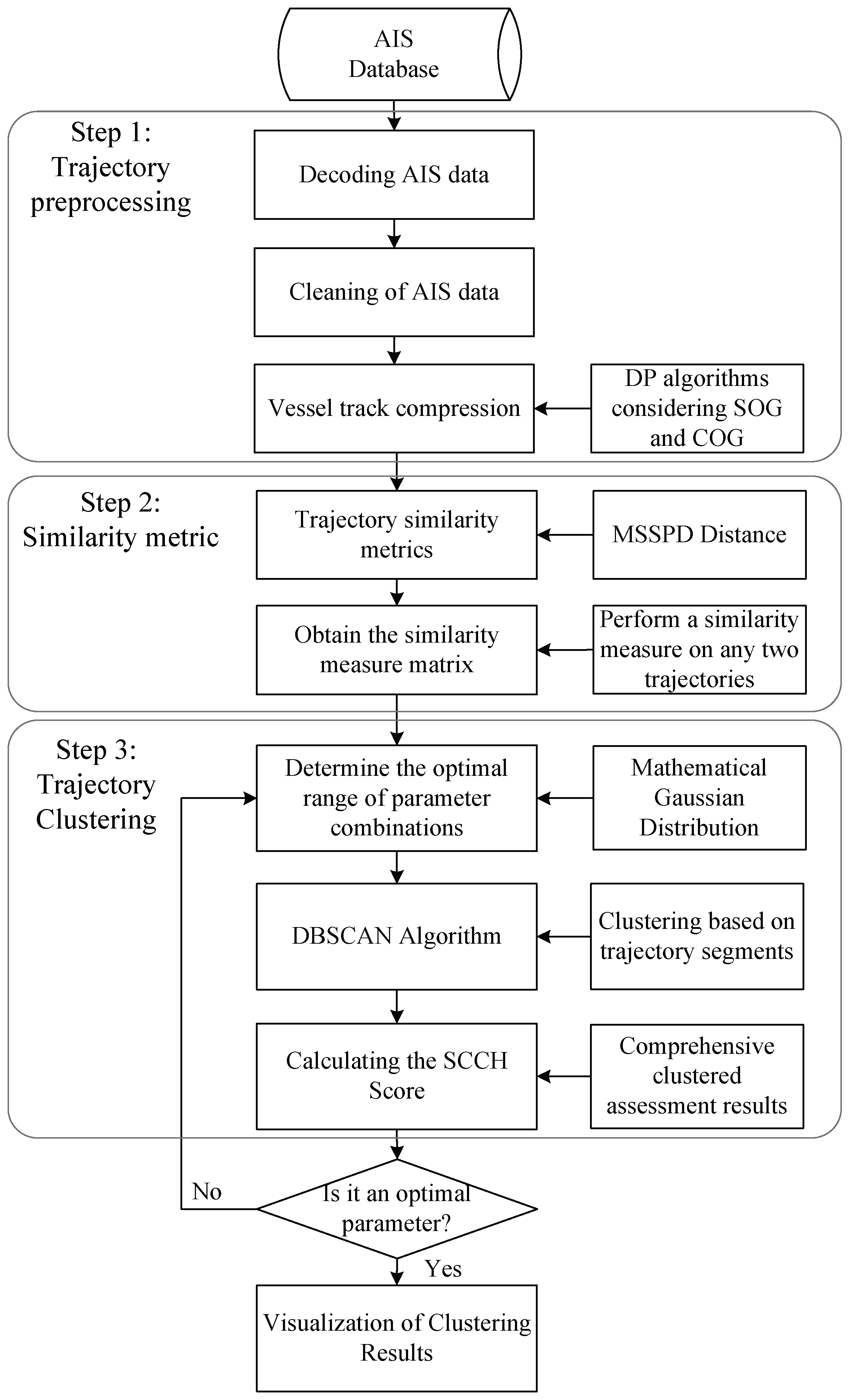
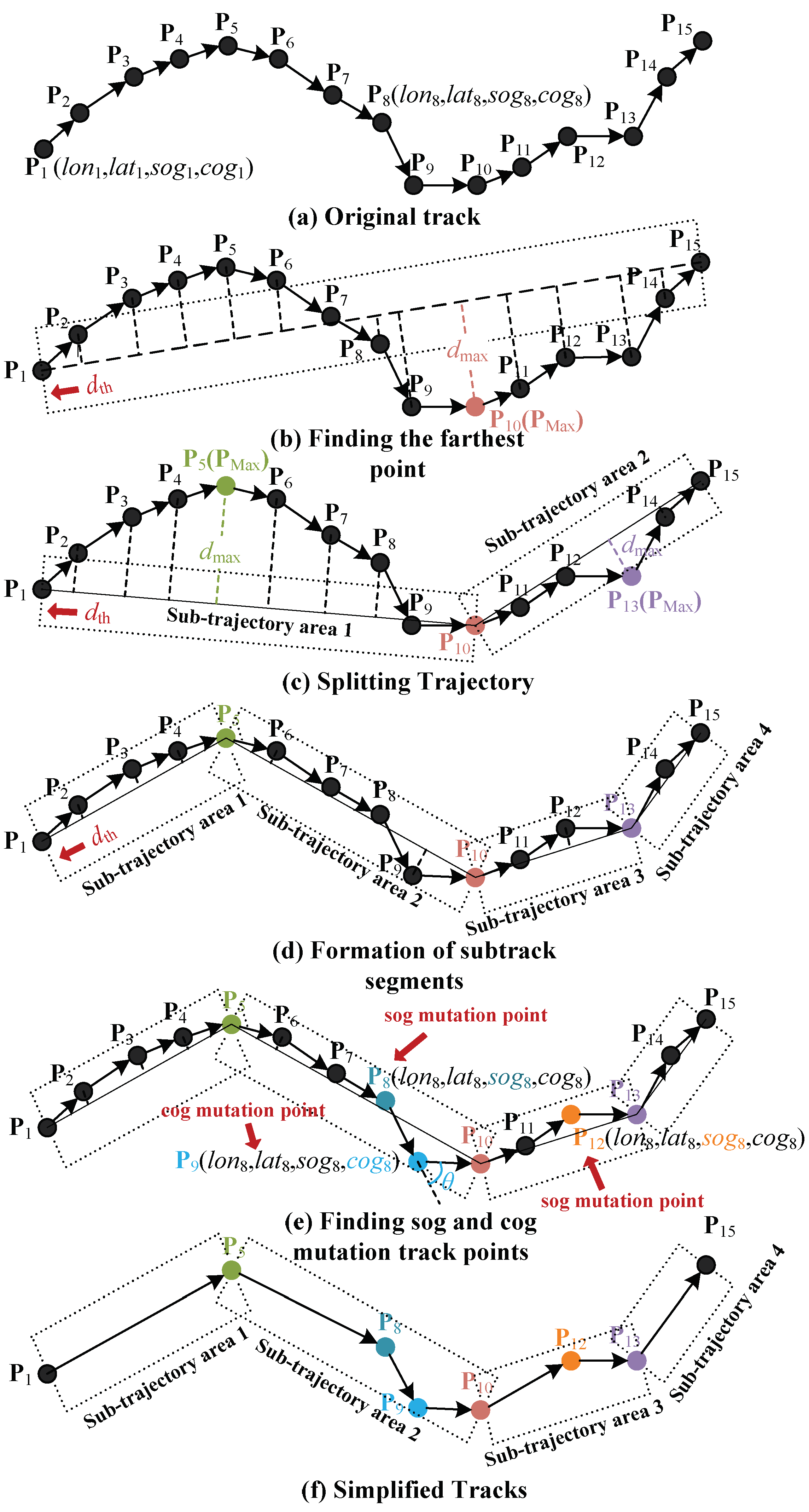
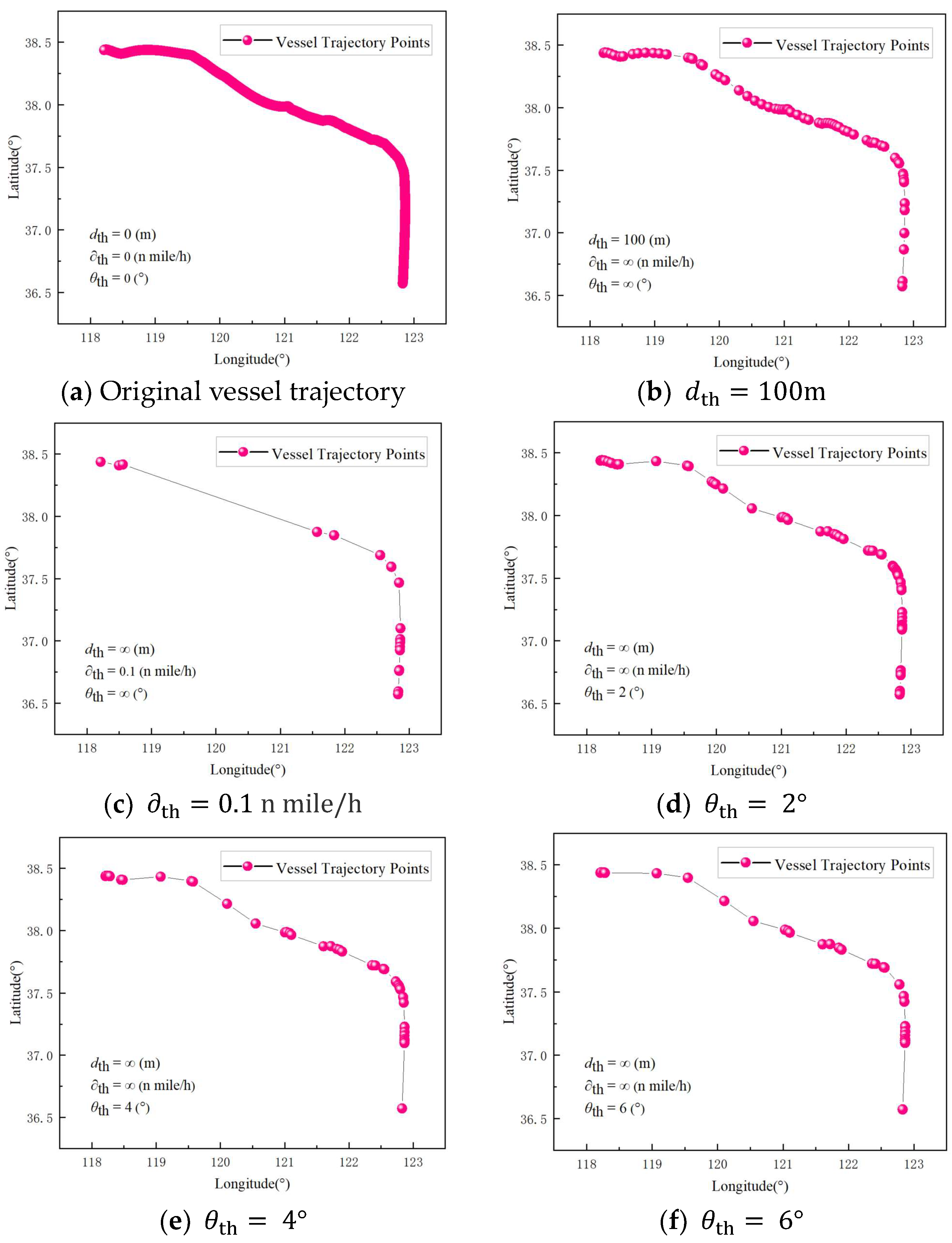
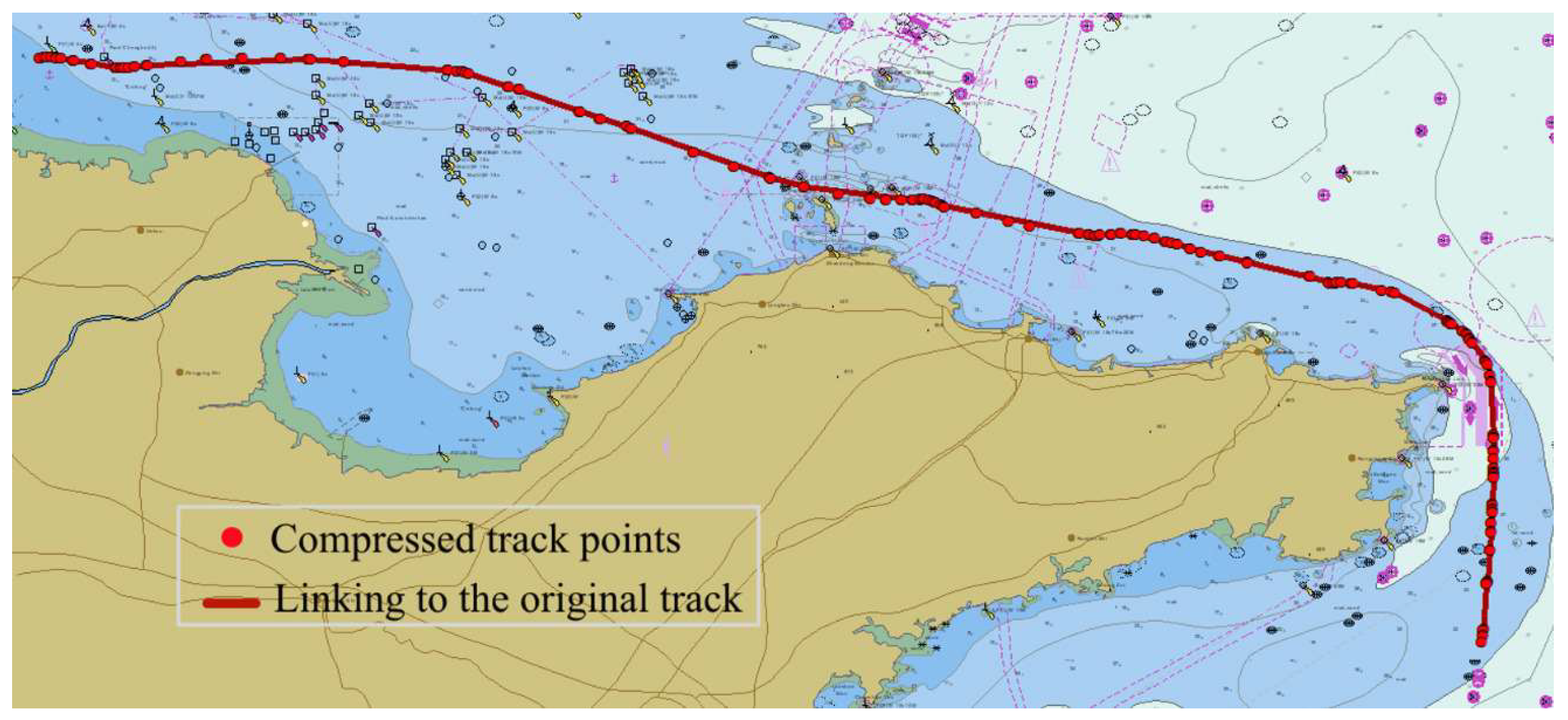
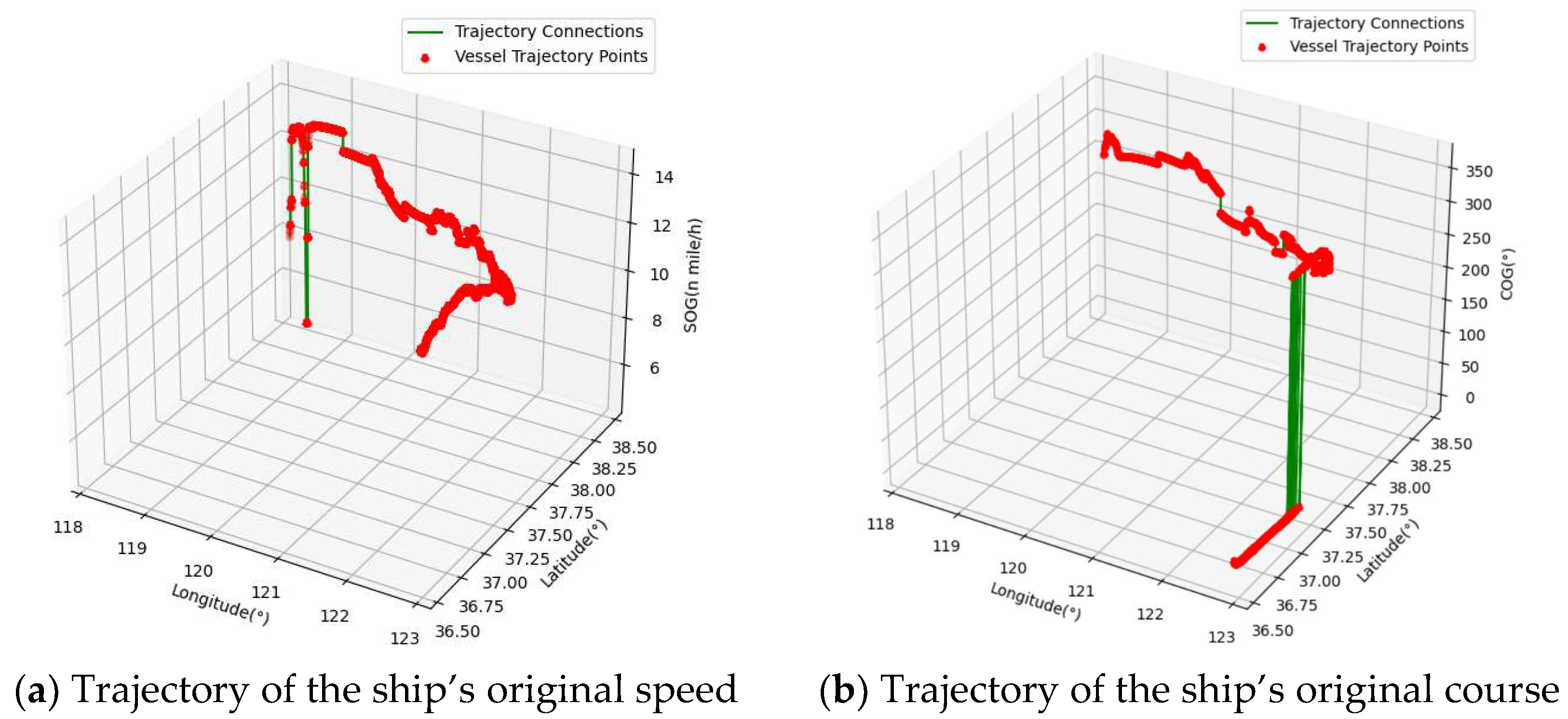




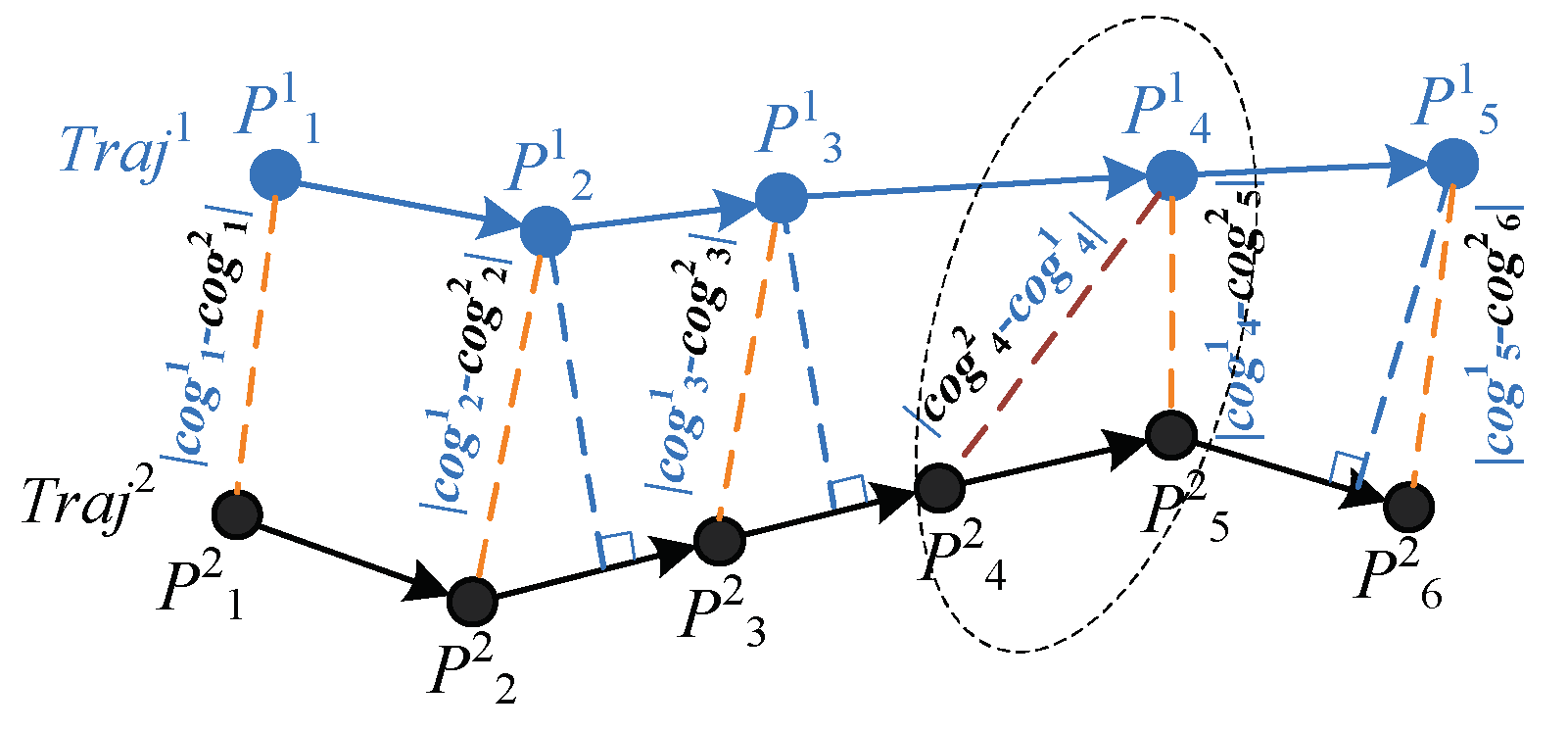
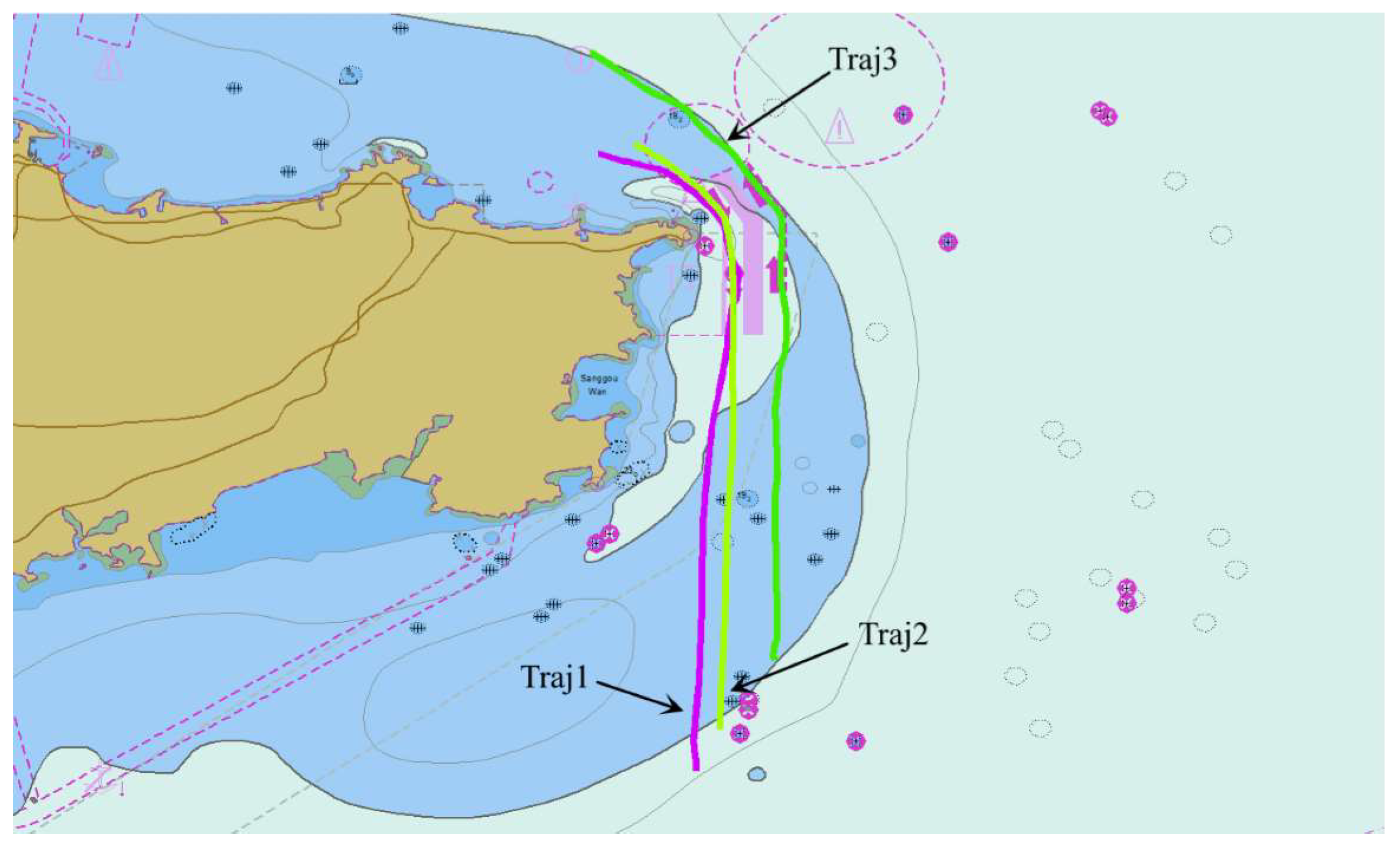
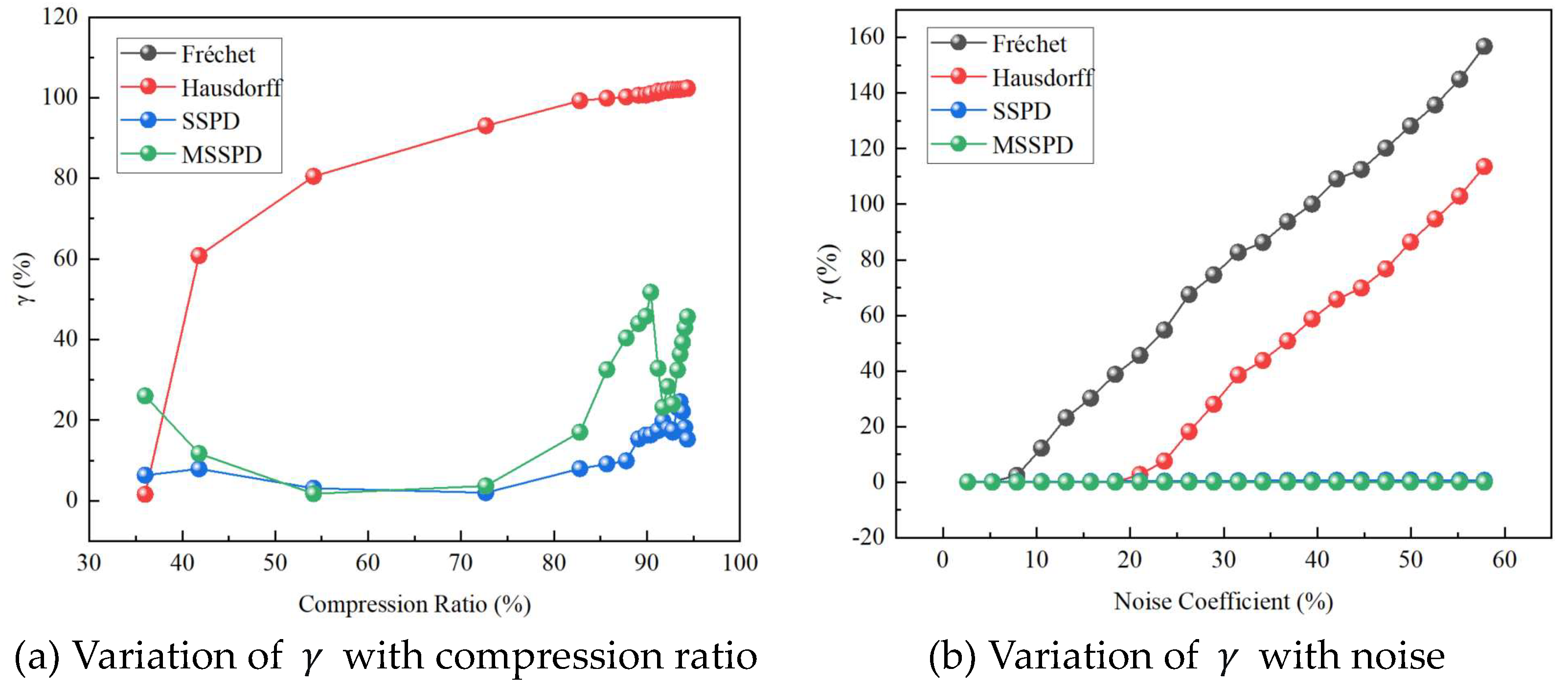
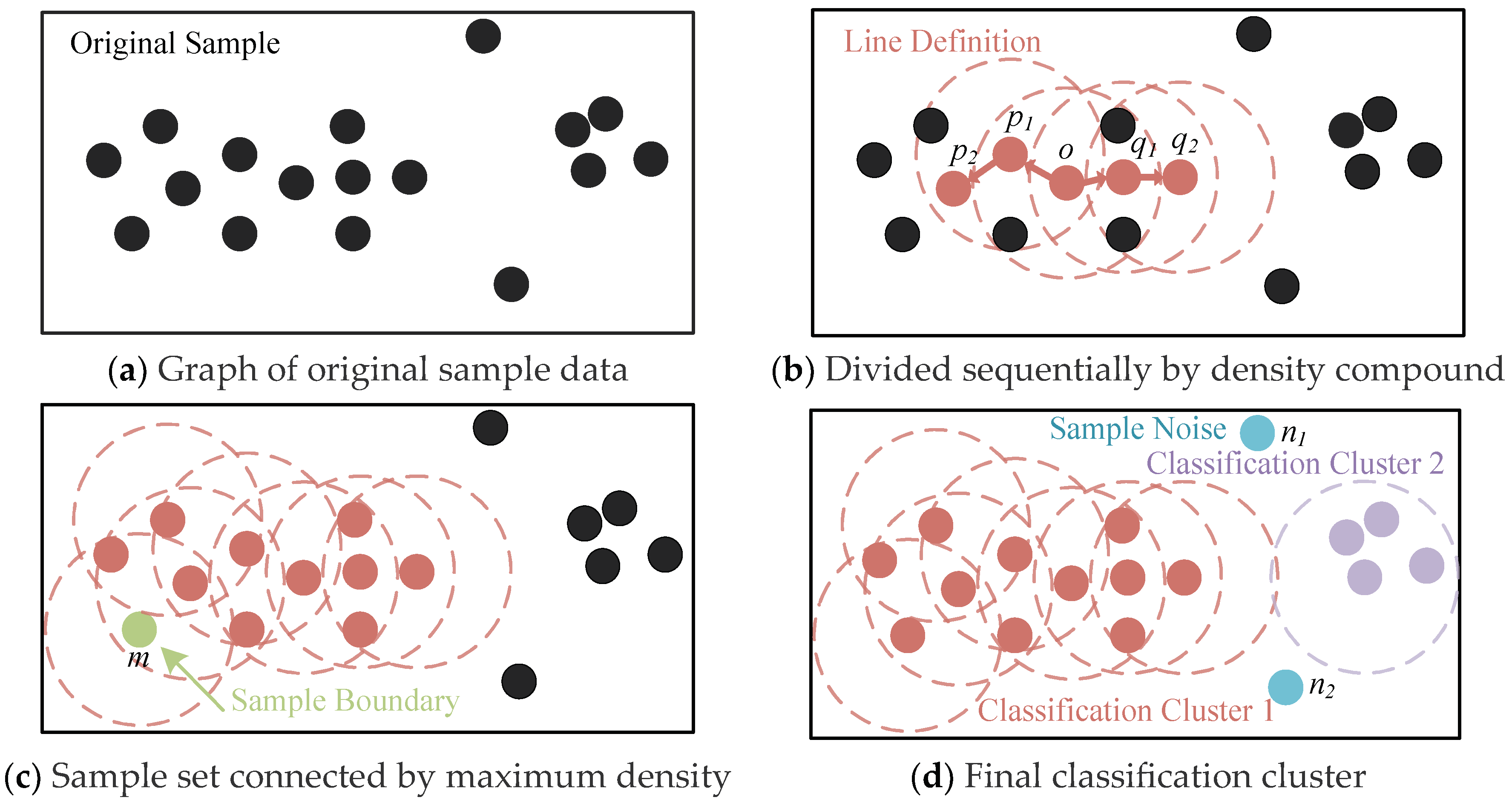
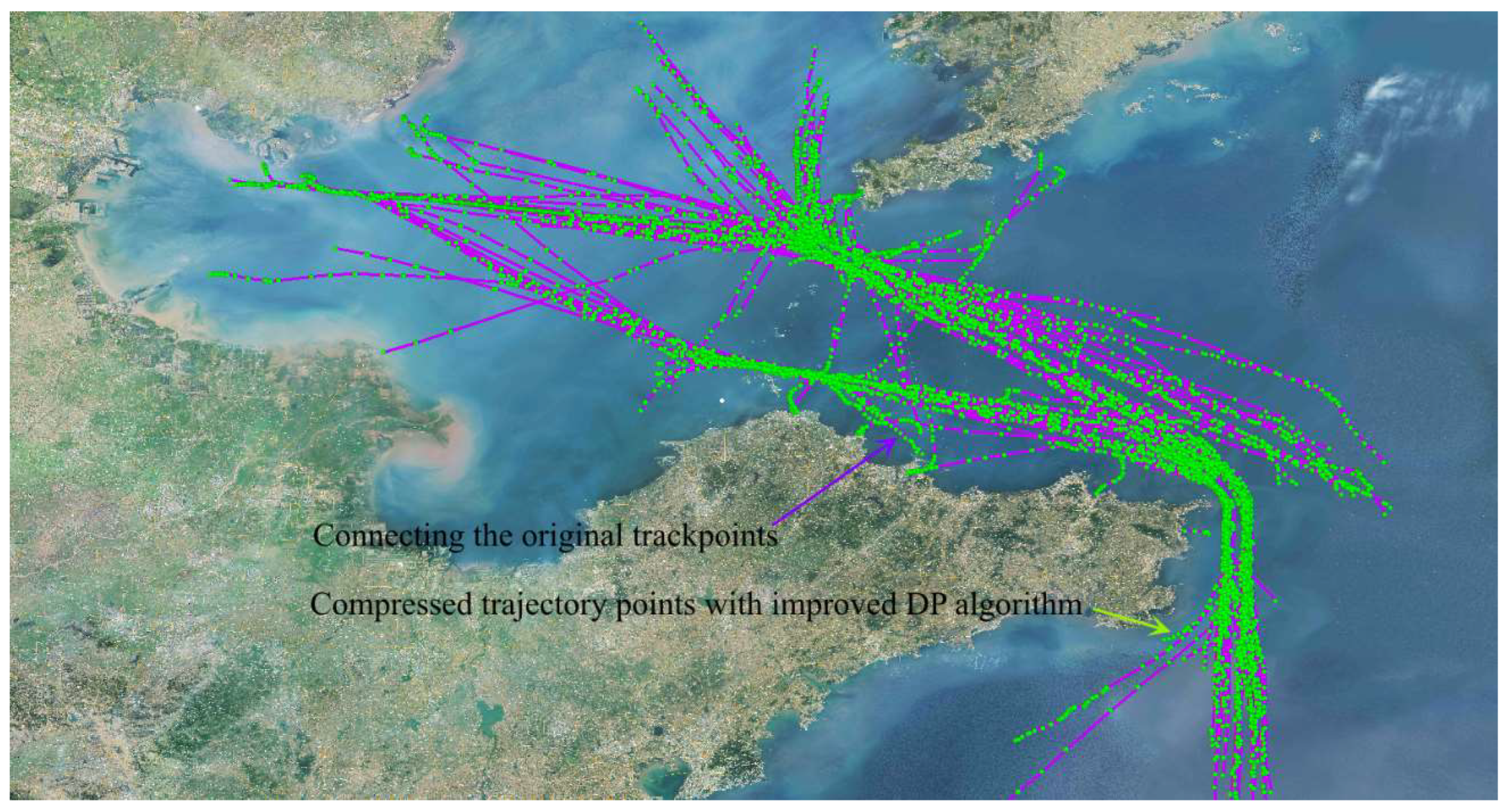



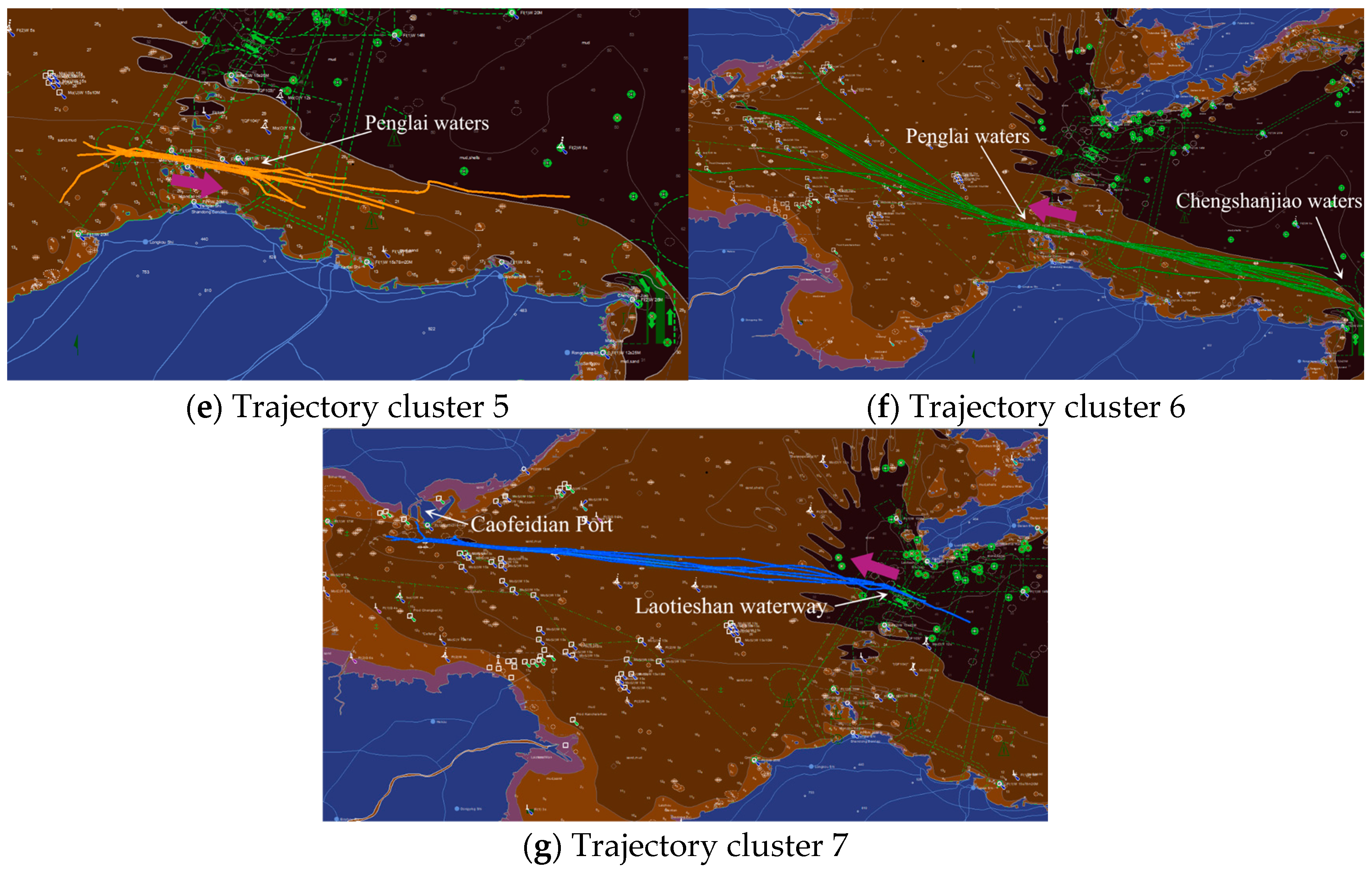
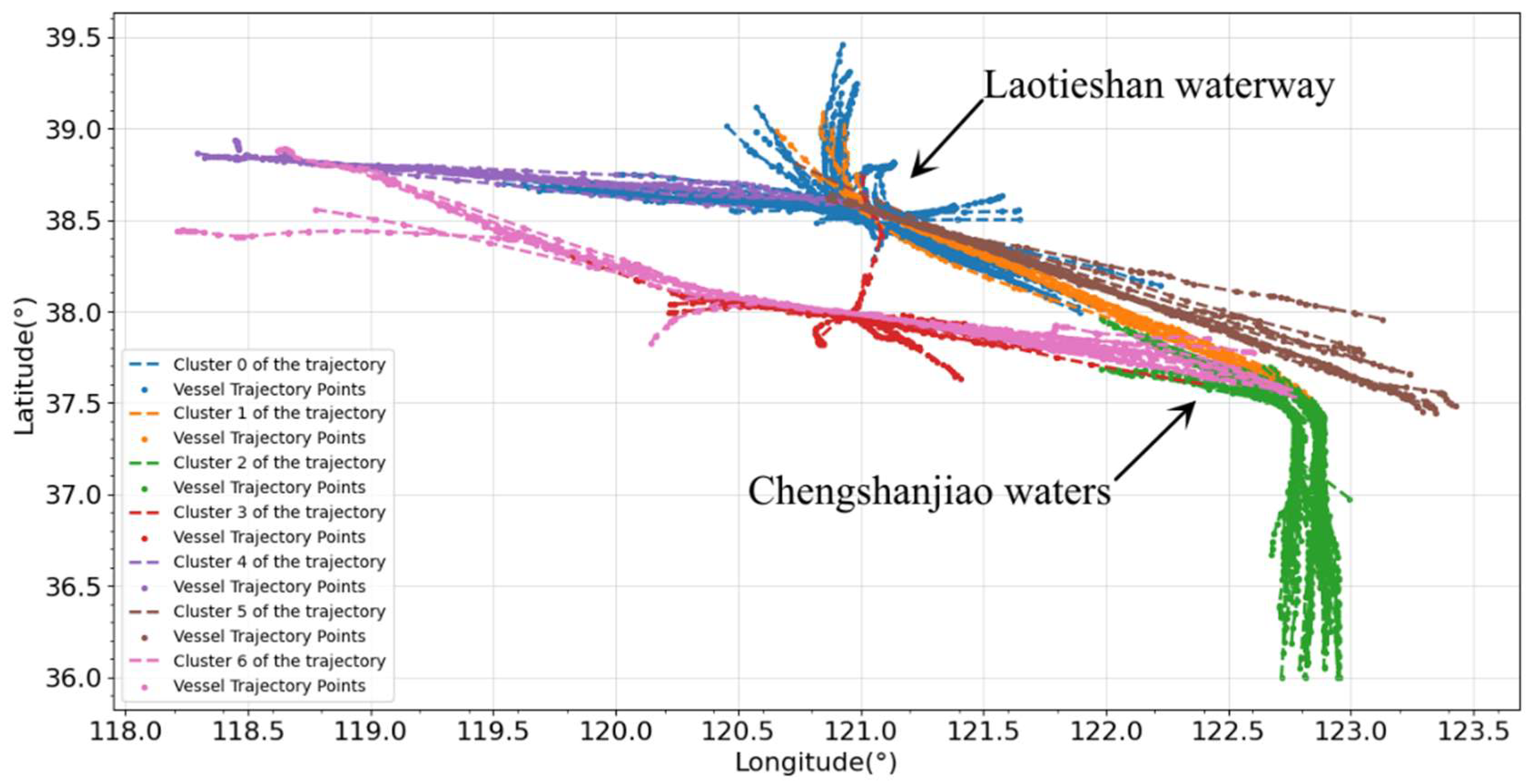
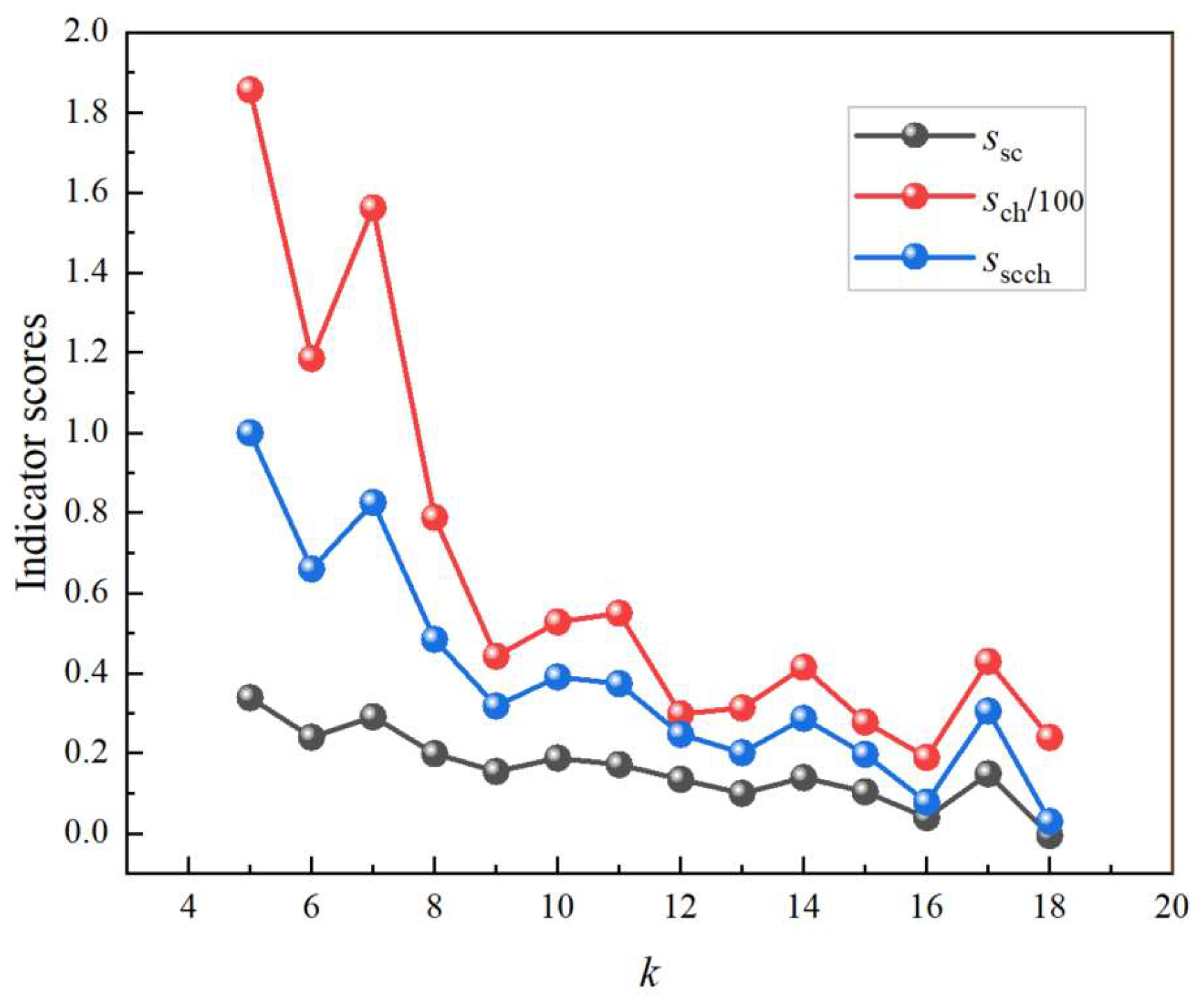

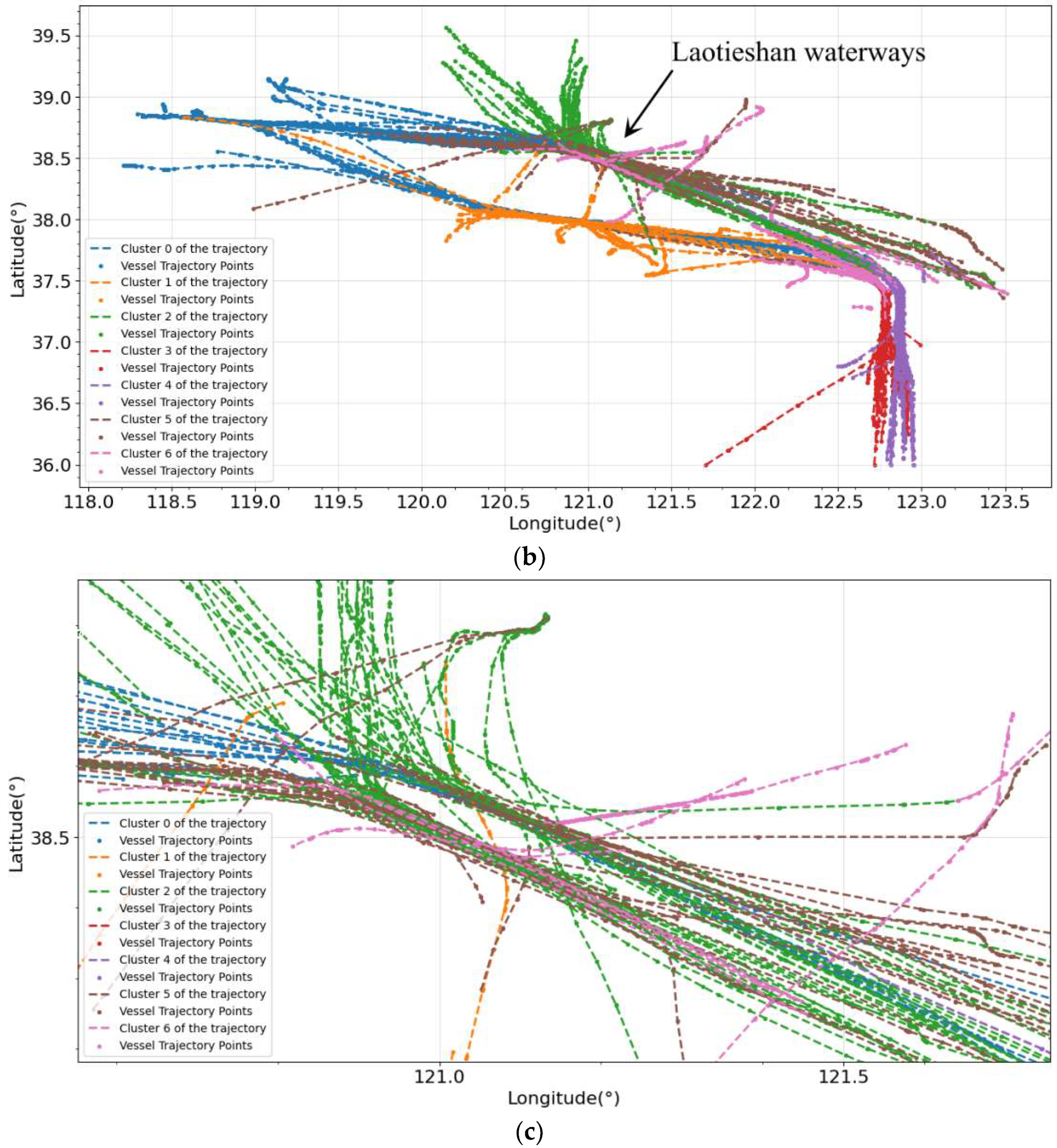
| Segmentation Threshold/m | Number of Track Divisions/pcs | Compression Rate/% |
|---|---|---|
| 10 | 512 | 86.41 |
| 40 | 212 | 94.37 |
| 70 | 166 | 95.59 |
| 100 | 144 | 96.17 |
| 130 | 122 | 96.76 |
| 160 | 104 | 97.24 |
| 190 | 98 | 97.39 |
| MMSI | Lat | Lon | SOG | COG |
|---|---|---|---|---|
| 413376XXX | 36.57289 | 122.8279 | 13.4 | 11.3 |
| 413376XXX | 36.57434192 | 122.8283067 | 13.4 | 11.5 |
| 413376XXX | 36.57580146 | 122.8286928 | 13.4 | 11.8 |
| 413376XXX | … | … | … | … |
| 413376XXX | 37.09926472 | 122.8648257 | 13.8 | 3.1 |
| 413376XXX | 37.10078638 | 122.8647726 | 13.7 | 359.4 |
| 413376XXX | 37.1022912 | 122.8649176 | 13.8 | 3.3 |
| 413376XXX | 37.10381002 | 122.864899 | 13.7 | 3 |
| 413376XXX | … | … | … | … |
| 413376XXX | 37.11441708 | 122.865203 | 13.6 | 359.4 |
| 413376XXX | 37.11593583 | 122.8651866 | 13.6 | 3.2 |
| Trajectory Direction | Fréchet | Hausdorff | SSPD | MSSPD |
|---|---|---|---|---|
| 0.0959086 | 0.0959086 | 0.0212184 | 2.11073107 | |
| 1.3807794 | 0.20357419 | 0.10195180 | 32.96917108 |
| Algorithm | Number of Vessels | Number of Data Points |
|---|---|---|
| AIS data from Bohai Bay waters | 203 | 207,878 |
| Recovering AIS data | 192 | 367,642 |
| AIS data after improved DP algorithm compression | 189 | 14,951 |
| 0.015 | 2 | −0.289457634 | 8.758875864 | 0.043449178 |
| 0.015 | 3 | −0.346612402 | 12.03505268 | 0.012246281 |
| 0.015 | 4 | −0.333376738 | 13.34814178 | 0.027216361 |
| 0.015 | 5 | −0.309855461 | 13.7711779 | 0.046678587 |
| 0.02 | 2 | −0.054437351 | 17.48593786 | 0.254733679 |
| 0.02 | 3 | −0.08274632 | 26.70577577 | 0.267676702 |
| 0.02 | 4 | −0.155981746 | 27.62205749 | 0.215428016 |
| 0.02 | 5 | −0.143978363 | 40.10239897 | 0.271204271 |
| 0.025 | 2 | 0.103668609 | 25.27935098 | 0.404057786 |
| 0.025 | 3 | 0.058517116 | 38.81419037 | 0.420326473 |
| 0.025 | 4 | 0.004149923 | 42.94318745 | 0.394430521 |
| 0.025 | 5 | −0.032582533 | 49.03618303 | 0.38928192 |
| … | … | … | … | … |
| 0.045 | 2 | 0.173343901 | 68.60526303 | 0.618976453 |
| 0.045 | 3 | 0.300944623 | 112.0998189 | 0.878560544 |
| 0.045 | 4 | 0.283545298 | 116.8461268 | 0.88307514 |
| 0.045 | 5 | 0.273372648 | 126.7816224 | 0.912480546 |
| 0.05 | 2 | 0.086681176 | 54.36319609 | 0.499858713 |
| 0.05 | 3 | 0.27910584 | 83.01418601 | 0.753237162 |
| 0.05 | 4 | 0.272738358 | 96.48516315 | 0.798750822 |
| 0.05 | 5 | 0.31110739 | 142.5209879 | 1 |
| 0.055 | 2 | −0.110951488 | 12.79359605 | 0.194231634 |
| 0.055 | 3 | −0.022697176 | 19.27984245 | 0.285568206 |
| 0.055 | 4 | −0.031851711 | 21.82144172 | 0.288109354 |
| 0.055 | 5 | 0.016119474 | 28.52876592 | 0.349648991 |
| … | … | … | … | … |
| 0.065 | 4 | 0.0345091424 | 31.33156007 | 0.374105432 |
| 0.065 | 5 | 0.0353367950 | 29.19900197 | 0.366763368 |
| 0.01 | 2 | −0.288136904 | 19.18257089 | 0.170773195 |
| 0.01 | 3 | −0.352534069 | 36.20556734 | 0.172885163 |
| 0.01 | 4 | −0.373057327 | 39.28322682 | 0.169017664 |
| 0.01 | 5 | −0.336761958 | 38.71536846 | 0.185286463 |
| 0.015 | 2 | 0.042542118 | 46.05719153 | 0.38098194 |
| 0.015 | 3 | 0.046493566 | 66.76909805 | 0.422933407 |
| 0.015 | 4 | 0.110587394 | 117.551548 | 0.55182477 |
| 0.015 | 5 | 0.070944148 | 130.2145122 | 0.557348237 |
| … | … | … | … | … |
| 0.03 | 2 | 0.223560855 | 107.5873265 | 0.586609302 |
| 0.03 | 3 | 0.257653188 | 119.7185631 | 0.626386396 |
| 0.03 | 4 | 0.329178752 | 194.1145125 | 0.804506752 |
| 0.03 | 5 | 0.329132626 | 259.9727785 | 0.931866945 |
| 0.035 | 2 | 0.207084944 | 125.4723116 | 0.613318587 |
| 0.035 | 3 | 0.323694252 | 153.1936876 | 0.722733881 |
| … | … | … | … | … |
| 0.05 | 2 | −0.245108515 | 1.46635869 | 0.157095569 |
| 0.05 | 3 | −0.245108515 | 1.46635869 | 0.157095569 |
Disclaimer/Publisher’s Note: The statements, opinions and data contained in all publications are solely those of the individual author(s) and contributor(s) and not of MDPI and/or the editor(s). MDPI and/or the editor(s) disclaim responsibility for any injury to people or property resulting from any ideas, methods, instructions or products referred to in the content. |
© 2023 by the authors. Licensee MDPI, Basel, Switzerland. This article is an open access article distributed under the terms and conditions of the Creative Commons Attribution (CC BY) license (https://creativecommons.org/licenses/by/4.0/).
Share and Cite
Liu, C.; Zhang, S.; Cao, L.; Lin, B. The Identification of Ship Trajectories Using Multi-Attribute Compression and Similarity Metrics. J. Mar. Sci. Eng. 2023, 11, 2005. https://doi.org/10.3390/jmse11102005
Liu C, Zhang S, Cao L, Lin B. The Identification of Ship Trajectories Using Multi-Attribute Compression and Similarity Metrics. Journal of Marine Science and Engineering. 2023; 11(10):2005. https://doi.org/10.3390/jmse11102005
Chicago/Turabian StyleLiu, Chang, Shize Zhang, Lufang Cao, and Bin Lin. 2023. "The Identification of Ship Trajectories Using Multi-Attribute Compression and Similarity Metrics" Journal of Marine Science and Engineering 11, no. 10: 2005. https://doi.org/10.3390/jmse11102005
APA StyleLiu, C., Zhang, S., Cao, L., & Lin, B. (2023). The Identification of Ship Trajectories Using Multi-Attribute Compression and Similarity Metrics. Journal of Marine Science and Engineering, 11(10), 2005. https://doi.org/10.3390/jmse11102005





